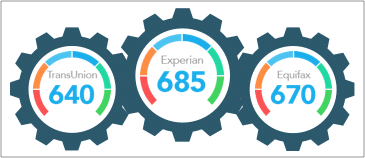Your credit score may determine your ability to get loans, your next apartment, or even utility service. But do you know the factors that determine your credit score?
Your VantageScore credit scores are calculated using six factors, and each factor has a different level of influence over your scores.
What Are the 6 Credit Score Factors?

The six factors and their level of importance to determining your scores include:
Payment History – 40%
Account Mix & Credit Age – 21%
Credit Utilization – 20%
Balances & Debt – 11%
New Activity – 5%
Available Credit – 3%
It’s important to know the six factors that affect your credit score because if you want to change your score, that starts with changing these factors. Here’s a quick look at each factor and what it means.
Payment History
Your payment history is the most important factor in determining your credit score. Payment history is a measurement of how well you’ve paid bills on time over a period of months or years.
Payment history is so important because the credit bureaus assume that your history of bill payment can predict how you will handle debt in the future. Typically, the highest credit scores reflect that a person consistently pays bills on time.
Account Mix & Credit Age
Lenders like to see that a potential borrower has successfully handled different types of credit, such as revolving credit and installment credit. Account mix is a measurement of the different types of accounts included in your credit profile. For example, a strong mix of accounts might include an auto loan (installment) and a credit card account (revolving).
Credit age is the average age of all your accounts. So, if you have had one credit card for 20 years and a mortgage loan for 10 years, your credit age would be 15. The longer the length of your credit history, the better lenders are often able to determine your creditworthiness.
Credit Utilization
Your credit utilization shows what percentage of your total available credit you are currently using. It’s figured as a ratio of your total debts against your total credit.
The assumption is that borrowers who are already using most or all the credit available to them may have a difficult time managing and repaying additional debt.
Balances & Debt
The amount of debt you currently owe, based on the balances on each of your credit accounts, influences your credit score. If you’re carrying a lot of debt, even if your debt-to-income ratio is low, that can have a negative effect on your score. Your income is not factored into your credit score.
New Activity
New credit activity is reflected in your credit score if the new activity is a credit inquiry that shows you are applying for a new loan or other credit. However, there’s a difference between a hard inquiry and a soft inquiry – a “hard” credit check is the only one that will affect your credit score; a “soft” credit check will not.
Available Credit
Available credit is the amount of credit that is currently available for you to use. For example, if you have a credit card with a $2,000 limit and a balance of $1,000, your available credit is $1,000. Higher available credit is more positive for your credit score. It’s best to pay off as much of your debt as possible to increase your available credit.
ScoreSense makes it easy to track all three of your credit reports and scores and see the factors that are influencing your scores. Members can also contact our credit specialists who can answer credit questions. If you’re not a member, try a 7-day trial now.




